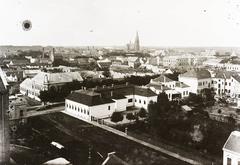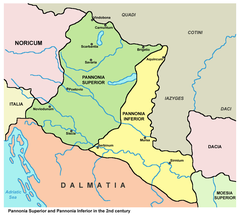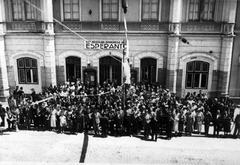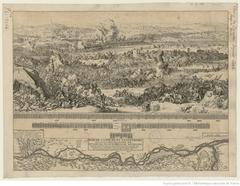Comprehensive Guide to Visiting Poučna staza Sakadaš, Osijek, Croatia
Publication Date: 18/07/2024
Introduction
Poučna staza Sakadaš, or the Sakadaš Educational Trail, is a noteworthy destination nestled within the Kopački Rit Nature Park near Osijek, Croatia. This trail is a blend of rich historical heritage and ecological marvels, making it an ideal spot for nature enthusiasts, history buffs, and casual visitors alike. The region’s history dates back to prehistoric times, with significant developments during the Roman, Medieval, Ottoman, and Habsburg eras. The area’s strategic location on the Drava River has made it a focal point for various civilizations, each leaving its mark on the landscape and culture (Croatian History).
Kopački Rit Nature Park, established in 1967, is one of Europe’s oldest and most important wetlands, spanning approximately 238 square kilometers. It is home to a diverse array of wildlife, including over 2,000 biological species and 300 bird species, making it a crucial site for both ecological research and conservation efforts (Kopački Rit Nature Park). The Poučna staza Sakadaš trail within this park offers an immersive experience, complete with informational panels, interactive exhibits, and guided tours that educate visitors about the region’s ecological and cultural significance.
This guide provides comprehensive information on visiting Poučna staza Sakadaš, covering everything from historical background and ecological importance to practical visitor information and travel tips. Whether you’re planning your first visit or seeking to deepen your understanding of this unique site, this guide aims to enhance your experience and appreciation of the Sakadaš Educational Trail.
Table of Contents
- Introduction
- Historical Background
- Significance of Poučna staza Sakadaš
- Visitor Information
- Travel Tips
- Conservation Efforts
- Cultural Significance
- Research Opportunities
- Future Developments
- FAQ
- Conclusion
Historical Background
Early Settlement and Development
The region surrounding Poučna staza Sakadaš has a rich history dating back to prehistoric times. Archaeological findings suggest that the area was inhabited as early as the Neolithic period. The fertile plains of the Drava River provided an ideal environment for early agricultural communities. Evidence of these early settlements can be found in the numerous artifacts and remnants of ancient dwellings unearthed in the region (Croatian History).
Roman Influence
During the Roman era, the area now known as Osijek was an important part of the Roman province of Pannonia. The Romans established the settlement of Mursa, which became a significant military and trade center. The strategic location of Mursa on the Drava River facilitated the movement of goods and troops, contributing to the prosperity of the region. Remnants of Roman architecture, including roads, bridges, and fortifications, can still be seen in and around Osijek (Roman Empire).
Medieval Period
Following the decline of the Roman Empire, the region experienced a period of turbulence and change. The arrival of the Slavs in the 7th century marked the beginning of a new era. Osijek became part of the medieval Kingdom of Croatia and later the Kingdom of Hungary. During this time, the area saw the construction of fortresses and churches, reflecting the growing importance of the settlement. The medieval period also witnessed the development of trade routes that connected Osijek with other parts of Europe (Medieval Croatia).
Ottoman Conquest
In the 16th century, Osijek fell under Ottoman rule, which lasted for over 150 years. The Ottomans transformed Osijek into a significant administrative and military center. They constructed a wooden bridge over the Drava River, which was one of the longest wooden bridges in Europe at the time. The Ottoman influence is still evident in the architecture and urban layout of the city. The period of Ottoman rule also brought about significant demographic changes, with the influx of various ethnic groups (Ottoman Empire).
Habsburg Era
The liberation of Osijek from Ottoman rule in the late 17th century marked the beginning of the Habsburg era. The Habsburgs initiated a period of reconstruction and modernization. The city was fortified with new walls and bastions, and the wooden bridge was replaced with a more durable structure. The Habsburg administration also promoted economic development, leading to the growth of trade and industry in the region. The influence of the Habsburgs is still visible in the Baroque architecture of Osijek (Habsburg Monarchy).
19th and 20th Centuries
The 19th century was a period of significant transformation for Osijek. The city became part of the Austro-Hungarian Empire, and industrialization brought about rapid urbanization. The construction of railways and the development of new industries, such as milling and brewing, contributed to the economic growth of the region. The 20th century, however, was marked by the turmoil of two World Wars and the subsequent political changes. Osijek became part of the Kingdom of Yugoslavia and later the Socialist Federal Republic of Yugoslavia (Yugoslav History).
Modern Era and the Croatian War of Independence
The breakup of Yugoslavia in the early 1990s led to the Croatian War of Independence. Osijek was heavily affected by the conflict, with significant damage to infrastructure and loss of life. The city has since undergone extensive reconstruction and revitalization. Today, Osijek is a vibrant urban center with a rich cultural heritage. Poučna staza Sakadaš, as part of the broader efforts to promote tourism and environmental awareness, plays a crucial role in preserving the natural and historical legacy of the region (Croatian War of Independence).
Significance of Poučna staza Sakadaš
Poučna staza Sakadaš is an integral part of the Kopački Rit Nature Park, one of the most important wetland areas in Europe. The trail offers visitors a unique opportunity to explore the diverse flora and fauna of the region while also learning about its historical significance. The trail is designed to educate visitors about the ecological and cultural importance of the area, highlighting the need for conservation and sustainable tourism practices (Kopački Rit Nature Park).
Visitor Information
- Visiting Hours: Poučna staza Sakadaš is open year-round. Specific visiting hours may vary seasonally, so it’s advisable to check the official website or contact the Kopački Rit Nature Park authorities for the latest information.
- Tickets: Entrance fees apply, and tickets can be purchased at the park’s entrance or online. Discounted rates are available for children, students, and groups. Guided tours may have additional costs.
- Accessibility: The trail is designed to be accessible to visitors of all ages and abilities. Wheelchair access is available in most areas, and there are resting spots along the trail.
- Guided Tours: For those interested in a deeper understanding of the site’s history and natural environment, guided tours are available. These tours can be booked in advance through the Kopački Rit Nature Park website or visitor center.
Travel Tips
- Best Time to Visit: Each season offers a unique perspective on Poučna staza Sakadaš. Spring and autumn are particularly popular for bird watching, while summer provides lush greenery and vibrant wildlife.
- What to Bring: Comfortable walking shoes, water, sunscreen, and insect repellent are recommended. Binoculars and cameras can enhance the experience, especially for wildlife enthusiasts.
- Nearby Attractions: Other attractions in Osijek include the Tvrđa (Old Town), the Osijek Zoo, and the beautiful promenade along the Drava River. Combining these with a visit to Poučna staza Sakadaš can provide a well-rounded experience of Osijek’s cultural and natural heritage.
Conservation Efforts
Poučna staza Sakadaš plays a vital role in the ongoing conservation efforts within the Kopački Rit Nature Park. The park is a designated Ramsar site, recognized for its importance as a wetland of international significance. Conservation initiatives focus on preserving the park’s unique ecosystems, protecting endangered species, and promoting sustainable tourism practices (Ramsar Sites Information Service).
Cultural Significance
In addition to its ecological importance, Poučna staza Sakadaš holds cultural significance for the local community. The trail and the surrounding parklands have been used for centuries by local populations for fishing, hunting, and agriculture. Traditional practices and knowledge related to the sustainable use of natural resources are an integral part of the region’s cultural heritage. Cultural events and festivals are often held in the park, celebrating the rich history and traditions of the region (Cultural Events).
Research Opportunities
Poučna staza Sakadaš is also a valuable site for scientific research. The diverse ecosystems and species found within the Kopački Rit Nature Park offer numerous opportunities for ecological and environmental studies. Researchers from around the world visit the park to conduct studies on topics such as wetland ecology, species behavior, and climate change impacts. The trail provides access to various research sites and facilities, supporting ongoing scientific investigations and contributing to the global understanding of wetland ecosystems (Research Opportunities).
Future Developments
Looking ahead, there are plans to further enhance the visitor experience at Poučna staza Sakadaš. Future developments include the expansion of educational programs, the introduction of new interactive exhibits, and the improvement of trail infrastructure. These initiatives aim to attract more visitors and increase awareness of the park’s ecological and cultural significance. Additionally, ongoing conservation projects will continue to protect and preserve the unique ecosystems of the Kopački Rit Nature Park, ensuring that future generations can enjoy and learn from this remarkable natural treasure (Future Developments).
FAQ
Q - What are the Poučna staza Sakadaš visiting hours?
A - The trail is open year-round, but specific visiting hours may vary seasonally. Check the official Kopački Rit Nature Park website for the latest information.
Q - How much are the tickets for Poučna staza Sakadaš?
A - Entrance fees apply, with discounts for children, students, and groups. Tickets can be purchased at the park entrance or online.
Q - Is Poučna staza Sakadaš accessible for people with disabilities?
A - Yes, the trail is designed to be accessible to visitors of all ages and abilities, with wheelchair access available in most areas.
Q - Are guided tours available at Poučna staza Sakadaš?
A - Yes, guided tours are available and can be booked in advance. They provide a deeper understanding of the site’s history and natural environment.
Q - What should I bring when visiting Poučna staza Sakadaš?
A - Comfortable walking shoes, water, sunscreen, insect repellent, binoculars, and a camera are recommended for an enjoyable visit.
For more information and updates, follow Poučna staza Sakadaš on social media or visit the Kopački Rit Nature Park official website.
Conclusion
Visiting Poučna staza Sakadaš offers a multifaceted experience that intertwines natural beauty, historical depth, and cultural heritage. The trail not only serves as a gateway to the ecological wonders of the Kopački Rit Nature Park but also as a testament to the region’s rich historical tapestry. From its early settlements in prehistoric times to its significance in various historical eras, the area has continuously evolved, shaping and being shaped by the civilizations that inhabited it (Roman Empire, Medieval Croatia, Ottoman Empire, Habsburg Monarchy, Yugoslav History, Croatian War of Independence).
The trail’s integration within the Kopački Rit Nature Park underscores its ecological importance, offering a sanctuary for numerous species and a critical site for conservation and research (Kopački Rit Nature Park). The educational aspects of Poučna staza Sakadaš enrich visitors’ understanding of the delicate balance between human activity and natural ecosystems, promoting sustainable tourism and environmental awareness.
As you explore Poučna staza Sakadaš, you connect with both the natural world and the storied past of the Osijek region. This unique blend of history and nature makes the Sakadaš Educational Trail a must-visit destination in Croatia. Plan your visit today and immerse yourself in the ecological and cultural treasures that Poučna staza Sakadaš has to offer.
References
- Croatian History. (n.d.). Retrieved from https://www.croatianhistory.net
- Roman Empire. (n.d.). Retrieved from https://www.roman-empire.net
- Medieval Croatia. (n.d.). Retrieved from https://www.medievalcroatia.net
- Ottoman Empire. (n.d.). Retrieved from https://www.ottoman-empire.net
- Habsburg Monarchy. (n.d.). Retrieved from https://www.habsburg.net
- Yugoslav History. (n.d.). Retrieved from https://www.yugoslavhistory.net
- Croatian War of Independence. (n.d.). Retrieved from https://www.croatianwarofindependence.net
- Kopački Rit Nature Park. (n.d.). Visitor Information. Retrieved from https://www.kopacki-rit.com






